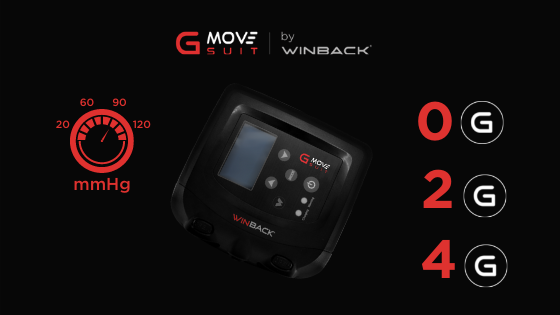The GMOVE-SUIT is based on active compression as a therapeutic method. This consists of applying pressure to the lower limbs. However, there is more to it than this simple explanation. Two factors must be taken into account to define the adaptability of GMOVE-SUIT: the pressure and the programs used. Indeed, they must be correlated during use in order to be exploited to the maximum effect. According to the pathologies and needs, the application of the active compression will be different.
Pressure
Without pressure, the GMOVE-SUIT obviously has no effect on users. The device has a wide range of pressures, from 20 to 120 mmHg, which offers a wide choice. The pressure applied will guide the application during the session. We offer three levels:
– The first level, ranging from 20 to 60 mmHg, is used to assist recognition of the lower limbs by acting on the mechanoreceptors. The application of low pressure can also influence lymphatic circulation.
– From 60 to 90 mmHg, the intention is to influence venous return in order to improve blood oxygenation.
– The third stage is from 90 mmHg to 120 mmHg and applies a pressure that moderates the blood supply to the muscles in order to intensify the efforts.
For more details on the importance of applying pressure, see this article:
https://www.gmovesuit.com/en/pressure-an-indispensable-factor/
The programs
GMOVE-SUIT offers three different programs to be used according to the applications sought.
The 0G program rhythms the inflation of the air chambers in the sleeves one after the other, starting at the bottom of the calf, moving up to the upper part and ending on the thigh. This is done in such a way as to alternate the deflation of one chamber and the inflation of the next.
2G works on the same principle, but at the end of the cycle (from the lower calf to the thigh) applies full compression to all three parts simultaneously. So there is alternating compression and then full compression.
4G offers inflation of all air chambers at the same time. The program is punctuated by 40 seconds at the required pressure and a return to calm with a lighter pressure for 20 seconds. This is a loop that will end at the end of the time you set beforehand.
You can reread one of our first articles about programs by following this link:
https://www.gmovesuit.com/gmove-des-programmes-tous-profils/
Programs and pressure
The factor for an efficient application is therefore the thoughtful combination of these two parameters.
The 0G program is therefore useful for influencing venous return in the active or passive recovery phase, by applying a pressure between 60 and 90 mmHg. The aim is to improve muscle recovery and/or reduce joint oedema/pain.
2G has a more or less similar rhythmic operation but with full compression of the limbs at the end. The alternating rhythm of inflation and deflation is aimed at better oxygenation of the blood and the constant pressure then makes the exercise slightly more intense. It is recommended to apply a pressure between 60 mmHg and 90 mmHg. Depending on the pressure, the intensity of the effort will be more or less important.
4G can be used in three different ways:
For athletes, the aim is to moderate the blood supply and consequently the oxygen supply to the muscle tissue. This allows intensive effort without heavy loads, with the intention of protecting health while offering muscle strengthening exercises. The pressure should be between 90 mmHg and 120 mmHg. This technique is also used in the rehabilitation of a patient at the end therapy cycle in order to protect him/her from any relapse. For this type of case, it will be necessary to apply around 90mmHg and adapt according to the patient’s sensations.
At the beginning of the rehabilitation, the therapist uses the GMOVE-SUIT to stimulate walking. Once the oedema has decreased, the patient wears the equipment in low pressure with the 4G mode so that the mechanoreceptors are activated. Following the pathology, these receptors are often diminished, and proprioception must therefore be reactivated. We therefore recommend a pressure between 20 and 60 mmHg.
Patients with psychomotor disorders such as Ehlers-Danlos syndrome, multiple sclerosis, Parkinson’s disease or post-stroke use the GMOVE-SUIT with a constant pressure. Indeed, a slight pressure (20 to 60 mmHg) influences the mechanoreceptors and thus increases proprioception.

